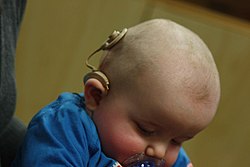Deafness
Deafness Media
The International Symbol for Deafness is used to identify facilities with hearing augmentation services, especially assistive listening devices.
Deafness is when someone cannot hear at all, or cannot hear well. Deafness is also known as 'hearing loss'. There were many famous people who were deaf, such as Ludwig van Beethoven and Helen Keller.
Definition
A person is considered to be deaf if they cannot hear the same range of sounds as a person with normal hearing ability. People that cannot hear any sounds are also deaf. People who are partially deaf may hear some sounds and may hear words.
People who cannot hear and understand words well are 'hard of hearing'. And people who cannot hear and speak are called "deaf-mute".
Things that help deaf people
- Hearing aid, which helps a deaf person to hear sounds.
- Teletypewriter (TTY), a machine that allows a deaf person to communicate with people.
- Sign language, a language which allows a deaf person to have a conversation with someone else.
- Hearing dog, a dog that has been trained to hear sounds and help a deaf person.
Causes
There are different causes of deafness:
- Age: Many people hear less well as they get older. Few lose all hearing, and when they do, there is a specific reason.
- Exposure to noise: Being in a noisy environment for a long time may damage ears and cause hearing loss.
- Genetic conditions: There may be a history of deafness in the family. If the mother and/or father are deaf, their child will have a strong chance of being deaf.
- Diseases: Certain diseases may cause deafness.
- Drugs: Certain drugs may cause changes to hearing, including deafness.
- Chemicals: Certain chemicals can damage the ear.
- Natural: People are occasionally born deaf. Sometimes there is no explanation why they are deaf.
Categories of deafness
Generally, there are two views of deafness:
- Medical view: the effects of deafness and measuring type and how much of loss (as seen in categories below).
- Sign language in deaf culture: includes people who use sign language to communicate and are part of group of people who share life experiences. Referring to people of the cultural group the phrase "Deaf people" is used and deaf is capitalized (as shown previously). A person using the medical view would write "people who are deaf".
These categories may overlap.
- Unilateral hearing loss – loss of hearing in one ear only
- Pre-lingual deafness – deafness at birth or deafness that started before language is learned
- Peri-lingual deafness – deafness that started while learning a first language
- Post-lingual deafness – deafness that started after a language has been learned
- Partial loss of hearing – limited hearing loss
- Progressive hearing loss – hearing loss that becomes worse as time passes
- Profound hearing loss – complete or near-complete hearing loss
- Tone deaf – not able to hear differences in relative pitch (in music)
- Tinnitus – hearing damage that causes high pitched ringing. This makes it so that the person cannot hear other sounds
- Conductive – hearing loss caused by sound being blocked from going into ears
- Sensorineural – hearing loss caused by hair cells in ears being damaged




